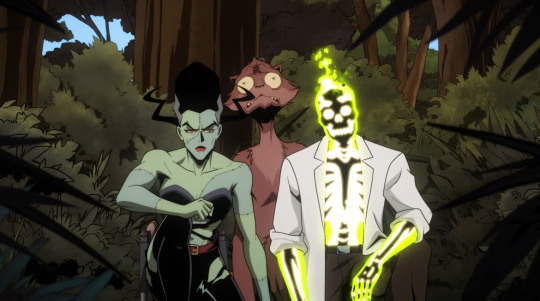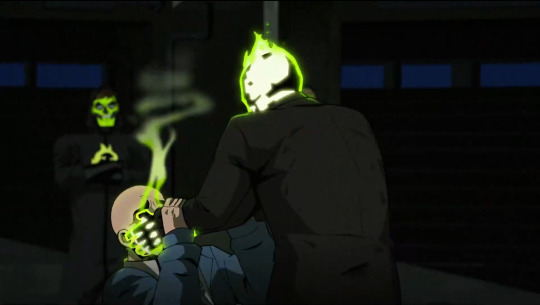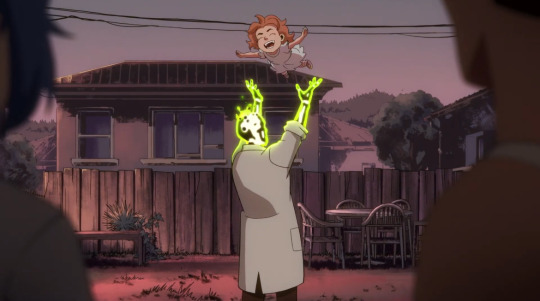#phosph
Explore tagged Tumblr posts
Text


from the past
260 notes
·
View notes
Text



@vancody:
After 2 years of dragons' existence, I finally got around to making good arts for them. The finished art with Bismuth has been around for about the same amount of time XD I'm so happy with how it looks XD
Masterpost
Rubellite/Ruby (14 lvl)
He's quite emotional and expressive person, whose face always tells what he's currently thinking. Thanks to his strong personality and temper, he easily steals the room's spotlight, however his short fuse and intemperance can lead to some unwanted consequences. This trait is balanced out by Phosphophyllite, with whom he spends a fair amount of time. Phosph is his voice of cold reason of sorts, who makes Ruby stop and ponder - which he usually does right after acting.
He was born on the planet as Pyroxene's ward at the same time as Phosphophyllite. They were developing together and, despite randomness of leveling up, at each level they looked the same, but in different palettes.
The catastrophe left a strong imprint on him, making Ruby blame himself for Pyro's death. Subsequently, he had difficulties controlling his emotions and inability to separate from Phosph for long periods, as he was terrified to lose him as well.
In an attempt to deal with his mental problems he took Twin as one of his levels to create Phosph's look-alike. It worked as a sort of workaround to help them separate for longer periods of time. At the moment a need for clone is gone, but it turned into a way to joke around, which the "brothers" sometimes use.
He belongs to a group of partners, among the members of that group is also Maple - with whom Ruby has closer connection. Maple is able to soothe his expressive temper, if needed. They often spend time together, canoodling, chatting, telling each other how the day went, sharing feelings. You could say these two have an equilibrium harmony.
Other members treat him with attention and interest, each expressing their feelings in their own way. They don't mind Ruby's company, but he's closest with Maple.
He was the first one one the moon to get a ward - a puddle by the name of Fate. This event had marked the beginning of major changes in his and the Dome's lives.
Rubellite is the head of metallurgical plant. In his free time he creates all sorts of metallic trinkets, which he later gifts to his friends.
Phosphophyllite/Phosph (14 lvl)
He appears to be a cold, calm and collected slime, whose gaze can send chills down your spine. In an unfamiliar company he keeps to an observer position, with minimal talking only when necessary. In familiar circles he's a bit more open, but still collected. Some take it upon themselves to try and piss him off (unsuccessfully). Phosph thoroughly thinks all his his actions through before actually doing anything. Phosphophyllite's demeanor is compensated by Rubellite, with whom he spends a fair amount of time. Ruby doesn't leave any time for thoughts, pushing Phosph to make decisions faster.
He was born on the planet as Pyroxene's ward at the same time as Rubellite. They were developing together and, despite randomness of leveling up, at each level they looked the same, but in different palettes.
The catastrophe left a strong imprint on him, making Phosph blame himself for Pyro's death. Subsequently, he started keeping to himself, pushing down all his emotions. Was unable to separate from Ruby for long periods as well, as he was terrified to lose him too.
In an attempt to deal with his mental problems he took Twin as one of his levels to create Ruby's look-alike. It worked as a sort of workaround to help them separate for longer periods of time. At the moment a need for clone is gone, but it turned into a way to joke around, which the "brothers" sometimes use.
After the relocation Ruby and him took Ren, who lived with them before his 9th level. After some time, Fate joined them as well.
Phosph is Loran's manager and partner. He serves as a restraint for his ambitions, helping him think more down-to-earth. Participates in planning future events, not letting Loran spend all mothly budget on a dramatic entrance.
Keid can't tell Rubi and Phosph apart based on looks, which creates comical situations. Ironically, he doesn't have any problem distinguishing Rosemarie and Passiflor.
Bismuth (15 lvl)
Having firm and strong spirit, she never doubts her decisions. Calm, even cold, at first glance, but only until you see her near her friends. Despite a high level and long life, makes risky decisions, weighing "pros" and "cons" beforehand. Consuming algae plort as the next level was one of them.
Bismuth is Keid's partner, complementing him both inside and outside. They met during the evacuation. They live not too far from the "Echo café", where they visit Ren and his family from time to time.
Thea and Ithra's mentor. Brought the former up on the planet, the latter one was spawned after the evacuation.
She works in metallurgical facility under the Dome - on the cast metal flattening line for producing flat sheets and their further processing. She doesn't pursue any creative work, preferring mechanical, structured work instead.
She's the oldest slime after the Lord and Sirius, and doesn't even plan on dying just yet. She'll outlive half the Dome!
#the last teleport#slime rancher fanart#slimerancher fanart#slime rancher#slime rancher 2#slimerancher#slime rancher au#slime rancher oc
12 notes
·
View notes
Text

I love and respect phosph) cube with biome
10 notes
·
View notes
Text
TRATADO DE CASOS CLÍNICOS:
1. Repertorio Clínico General.
I• ESTREÑIMIENTO.
a. Síntomas.
Disfunción colon transverso descendente, por retención de materia fecal; los factores causales y causísticos son diversos.
En situaciones emotivas dificultan digestión alimentaria o generan inapetencia ansiolítica o lo contrario, gula bulímica con variable constinpante - bulímica - diarreica - vomitiva.
Incluye desorden alimentario, estrés laboral, sedentarismo; agudiza dolores abdominales.
b. Evolución y complicaciones:
El estreñimiento, signo de mala higiene alimentaria o formas de vida disociativas o económicas; manifiesta multiples trastornos sino se considera seriamente tal disfunción colonica.
Enflaquecimiento u obesidad son consecuenciales; también fisura anal, autointoxicación con trastornos vasculares y hemorroides.
c. Tratamientos:
Es emergente cambios en higiene de vida, actividad física, hábitos alimentarios saludables equilibrados, considerando autoestima y propia calma ante la vida misma.
Medicación homeopática:
•Celuloterapia.
•Hepatogen.
•Arsenicum alb.
•Cáscara sagrada.
•Nux vom.
•Thymus vulg.
II• FLEBITIS.
a. Síntomas:
La inflamación de una vena debido a fomación de un acúmulo de sangre coagulada que la obstruye, provoca al principio dolor en el tobillo o planta del pie, calambres y pesantez en extremidades de tipo local.
Manifiesta edema en región de tibia hacia el pie, seguido de fiebre y entumecimiento mocado parésico con deformación de la pierna afectada e hinchada debido a calor interno con dolor intenso.
Los indicadores causales son variables; constante sedentarismo pseudodepresivo, falta de higiene alimentaria, obesidad, secuelas quirúrgicas, varices ulceradas, partos, abortos, vida desordenada, etc.
b. Evolución y complicaciones:
Mayormente el riesgo en la flebitis son los procesos ulcerosos, gangrenosis de tejidos, trombosis con embolias vasculares, arteriales en incidencia cerebral o cardio - pulmonar.
c. Tratamientos:
La asistencia clínica hospitalaria pública es importante, puede requerirse antibiótico y cirugía.
Medicación homeopática:
•Celuloterapia.
•Crema médica específica.
•Aesculus hippocast.
•Acidum hydrofluoric.
•Arsenicum alb.
•Hamamelis virgin.
•Taxaína.
III• GOTA.
a. Síntomas:
La gota es una enfermedad causística a menudo hereditaria en artritis reumatoidea, sedentarismo pseudodepresivo con gula bulímica, psoriasis y otros factores genomas haciendo presente la enfermedad.
Comenzando con crisis de inflamación que afectan a las articulaciones; los indicadores sintomáticos son temperamento irritable, trastornos digestivos, dolores de cabeza, rigidez muscular, dolor en riñones, orina nocturna abundante y fuerte.
Terminando con intenso dolor en dedo pulgar de un pie o ambos.
Crisis febril con piel ardiente y sensibilidad al menor tacto o movimiento, tumefacción en articulaciones afectadas agravandose en dedo pulgar.
b. Evolución y complicaciones:
La gota es manifiesta de afectar a varias articulaciones y ligamentos dando sensación de estado reumático agudo doloroso traumatológico de clínica general; puede complicarse con otras eventualidades que involucran a dierentes órganos aún dos o tres a la vez, sean corazón, riñones o cerebro e higado.
c. Tratamientos:
Medicación homeopática: •Ammoniun phosph.
•Celulotetapia.
•Colchicum autumn.
•Juniperus.
•Lespedeza cap.
•Taxaína.
IV• GRIPE.
a. Síntomas:
La gripe es una afección viral, que en general se da en determinada época del año y es muy contagiosa.
La sintomatología difiere acorde a estado inmunológico de cada niño, niña, adolescente, joven, adulto o ancianidad; normalmente se manifiesta gran fatiga y dolores musculares, seguido de resfriado que presenta estado febril que se agudiza según inmunidad de paciente.
b. Evolución y complicaciones:
Requiere control hospitalario público.
La gripe virósica es indicador endémico - epidémico; sus complicaciones manifiestan trastornos digestivos agudos y respiratorios que pueden agravarse a complicaciones de clínica general en niños, niñas, adolescentes, jóvenes, adultos y ancianidad.
Debe entenderse la importancia de ésta pandemia - epidemia; los niños y niñas de corta edad hasta 7 - 8 años pueden ser los más afectados.
La convalescencia del estado gripal, es relativa de 8 - 16 días.
c. Tratamientos.
Medicación homeopática:
•Bioterápico - nosode vacuna
antigripal homeopática.
•Celuloterapia.
•Belladonna.
•Eupatorium.
•Gelsemium.
•Influenzinum.
•Verbascum thapsus.
V• HERPES.
a. Síntomas:
Erupción de pequeñas vesícula en la piel y mucosas, que al abrirse forman una costra amarilla pardusca.
El herpes de origen viral, es una afección contagiosa.
Suele aparecer en la cara, en particular alrededor de la boca y la nariz; también en órganos genitales y nalgas.
b. Evolución y complicaciones:
Es de tendencia recidivante y riesgo de infección.
c. Tratamientos:
Medicación homeopática.
•Celuloterapia.
•Crema médica epecífica.
•Berberis.
•Cantharis.
•Rhus tox.
•Taxaína.
VI• MENOPAUSIA.
a. Síntomas:
Etapa de la vida femenina caracterizada, por cesación natural y progresiva del período menstrual = secreciones glándulo hematógenas mensual de los ovarios.
La menopausia manifiesta diversos síntomas, de los cuales pueden convertirse en patológicos; cesación del período, soflamas o arrebatos de calor congestivo neurogénico, trastornos circulatorios en extremidades, trastornos digestivos, dolores inguinales (bajo vientre), trastornos nerviosos y dificultades clínicas sexuales con síndrome depresivo.
b. Evolución y complicaciones:
Se manifiesta tendencia a la obesidad o delgadez excesiva, la artrosis con osteoporosis (reblandecimiento de los huesos por descalcificación).
En prevención es sugerible chequeo tocoginecológico, para descartar patología en glándulas mamarias y útero - vaginal.
c. Tratamientos:
Alimentación saludable y equilibrada, actividad física, ánimo en fortaleza de propia autoestima.
Medicación homeopática:
•Celuloterapia.
•Aquilea.
•Calcareas compuestas.
•Cimicifuga.
•CTX-Lachesis.
VII• MENOMETRORRAGIA. a. Síntomas:
Las pérdidas de sangre menorrágicas o metrorrágicas, que sobrevienen independiente del período menstrual; se deben a diversas causas de clínica general.
Lo que implica importancia, en asistencia hospitalaria pública.
b. Evolución y complicaciones:
Diversas causas son manifiestas; la desnutrición agravada a anemia perniciosa crónica, exigencia emotiva psicofísica por maltrato, suma exigente de actividades, gula bulímica y trastornos de coagulación.
c. Tratamientos:
Medicación homeopática:
•Celuloterapia:
•Aquilea.
•Bothrops.
•Bursa pastoris.
•Equisetum arvensis.
•Secale cornutum.
•Trillium pendulum.







0 notes
Text
CHINA DAP (Diammonium Phosphate) Market Sector Outlook: Beyond the Curve in a Climate of Slowdowns and Trade Barriers
Introduction: The latest research study from Prophecy Market Insights offers a thorough analysis of the DAP (Diammonium Phosphate) Market , focusing on risk assessment, opportunities, and strategic decision-making support. This report provides insights into market development, trends, growth factors, and investment structures, aiding businesses in navigating the evolving landscape of DAP (Diammonium Phosphate) Market. Report Sample: A brief overview of the research report. Graphical presentation of regional analysis. Revenue analysis of top players in the market. Selected illustrations of market insights and trends. Example pages from the report. DAP (Diammonium Phosphate) Market Overview: The research provides a systematic approach to gathering, evaluating, and interpreting market data, including customer preferences, competitor analysis, and sectoral trends. It helps companies understand customer needs, assess market demand, and identify growth opportunities. Market research offers valuable insights through surveys, interviews, and data analysis, guiding product development, marketing strategies, and decision-making processes. Request a Sample Strategic Report in PDF Format: https://www.prophecymarketinsights.com/market_insight/Insight/request-pdf/5620 Leading Key Players Operating in the DAP (Diammonium Phosphate) Market The Mosaic Company, OCP Group, Nutrien Ltd., PhosAgro, EuroChem Group, CF Industries Holdings, Inc., Yara International ASA, Israel Chemicals Ltd. (ICL), Coromandel International Limited, Ma'aden (Saudi Arabian Mining Company), Innophos Holdings, Inc., Sinochem Group, SABIC (Saudi Basic Industries Corporation), Wengfu Group, Hubei Xingfa Chemicals Group Co., Ltd. Key players are well-known, powerful businesses that have a big impact on a certain market or sector. Finding the important companies is essential to comprehending the dynamics of the industry or the competitive environment. Please be aware that changes in the industry, mergers, acquisitions, or the entry of new competitors may cause the status of important players to alter over timeDAP (Diammonium Phosphate) Market: Demand Analysis & Opportunity Outlook 2034 DAP (Diammonium Phosphate) Market analyzes customer preferences, economic trends, and industry dynamics to predict demand patterns and identify new opportunities. By leveraging data-driven research and predictive modeling, businesses can anticipate changes in market demand, plan product development, and position themselves proactively in the evolving business landscape of 2034. Major Market Analysis Findings: Consumer preferences: Businesses can better understand their target audience’s preferences by conducting market research, which can reveal things like preferred product features, pricing, and branding. The most crucial product characteristics, the most alluring pricing points, and the most effective brand messaging are just a few examples of key findings. Market size and growth potential: Businesses can evaluate the size of the market and its growth potential with the use of market research. The size of the market overall, the size of particular market segments, and the market’s anticipated growth rate are just a few examples of key findings. Market trends: Businesses can use market research to spot new market trends, such as alterations in customer behavior, adjustments to industry rules, or the arrival of new technologies. The most important market trends, the causes influencing those trends, and their possible effects on the company may be some of the key findings. Get a free sample of the report: https://www.prophecymarketinsights.com/market_insight/Insight/request-sample/5620 (The sample of this report is readily available on request) The segments and sub-section of DAP (Diammonium Phosphate) Market is shown below: Market Segmentation: DAP (Diammonium Phosphate) Market Size, Share, By Production Method (Wet-Process and Dry-Process), By Grade (Industrial Grade, Food Grade,
and Fertilizer Grade), By Application (Fertilizers, Food Additives, Metal Finishing, Fire Retardants, and Others), and By Region - Trends, Analysis and Forecast till 2034 Regional Analysis for DAP (Diammonium Phosphate) Market: This section of the report includes comprehensive information on DAP (Diammonium Phosphate) Market that is accessible in several fields. Each region offers a distinct DAP (Diammonium Phosphate) Market length as each state has its own executive insurance laws and components. North America - U.S., Canada Europe - UK, Germany, Spain, France, Italy, Russia, Rest of Europe Asia Pacific - Japan, India, China, South Korea, Australia, Rest of Asia-Pacific Latin America - Brazil, Mexico, Argentina, Rest of Latin America Middle East & Africa - South Africa, Saudi Arabia, UAE, Rest of Middle East & Africa Research Methodology The research methodology employed by Prophecy Market Insights for market research involves a systematic approach that integrates primary and secondary research techniques. Through direct interactions with industry experts and stakeholders, as well as comprehensive analysis of secondary sources, we gather valuable data on market trends, consumer behavior, and competitive landscape. Advanced data analysis techniques are then applied to interpret this data accurately, providing clients with actionable insights to make informed decisions and strategies in today's dynamic marketplaces. Top of Form About Us: Prophecy Market Insights is a leading provider of market research services, offering insightful and actionable reports to clients across various industries. With a team of experienced analysts and researchers, Prophecy Market Insights provides accurate and reliable market intelligence, helping businesses make informed decisions and stay ahead of the competition. The company's research reports cover a wide range of topics, including industry trends, market size, growth opportunities, competitive landscape, and more. Prophecy Market Insights is committed to delivering high-quality research services that help clients achieve their strategic goals and objectives. Contact Us: Prophecy Market Insights Website- https://www.prophecymarketinsights.com US toll free: +16893053270
0 notes
Text
Final Exam Notes: Myocardial Infarction Nursing Care & Treatment (NURS 101) Behaviors for Success in Health Careers (Minneapolis Community and Technical College) Scan to open on Studocu Studocu is not sponsored or endorsed by any college or university Final Exam Notes: Myocardial Infarction Nursing Care & Treatment (NURS 101) Behaviors for Success in Health Careers (Minneapolis Community and Technical College) Scan to open on Studocu Studocu is not sponsored or endorsed by any college or university Downloaded by James Mcknight ([email protected]) lOMoARcPSD|28323056 Cardiac Conditions 1. Review the anatomy and physiology of the heart, including the circulation of blood into and out of the heart and the conduction pathway within the heart. ● Trace the pathway of blood flow in the heart. (oxygen-poor blood enters the heart from the body and RIGHT into the lungs) - Superior vena cava & Inferior cava - Right Atrium - Tricuspid Valve - Right ventricle - Pulmonary Valve - Pulmonary Arteries - Lungs (oxygen-rich blood enters the heart from the lungs and LEAVES to the body) - Lungs - Pulmonary Veins - Left Atrium - Mitral Valve - Left Ventricle - Aortic Valve - Aorta - Body Tissues ● Review conduction pathway - SA node starts the sequence by causing Atrial muscles to contract. Next, the signal travels to the AV node, through the Bundles of HIS, down the bundle branches, and through the Purkinje Fibers, causing the Ventricle muscles to contract. - SA node ---> AV node ---> Bundle of HIS ---> Purkinje Fibers - SA node: Atria squeezes blood into ventricles - Signal travels down the conduction pathway: AV node, Bundle of HIS, Purkinje Fibers to contact ventricles squeezing blood out of the heart. ● Identify the four valves on a heart diagram. *insert picture of heart valves* 2. Describe the pathophysiology of coronary artery disease. ● Review the coronary arteries and their primary function. F24 Downloaded by James Mcknight ([email protected]) lOMoARcPSD|28323056 - coronary arteries supply and carry oxygen-rich blood to the heart muscle (myocardium) ensuring that it gets the oxygen and nutrients needed to function effectively ● What leads to the problem of CAD? What has contributed to the development of it? - Develops primarily due to a buildup of plaque (a mix of fat, cholesterol, and other substances) inside the coronary arteries. - Arteriosclerosis & Atherosclerosis which are loss of elasticity (hardening) of arteries and accumulation of fatty materials (cholesterol) which causes plaque build up. This plaque buildup narrows the arteries and restricts blood flow to the heart. - Risk Factors: - high cholesterol and triglyceride levels - high BP - smoking - diabetes - obesity - lack of physical activity - eating saturated fats - Two kinds of Plaque: - Hard and stable - Soft and stable: can lead to an embolus if it breaks off 3. Outline the benefits of low cholesterol, low fat diets in relationship to cardiac risk factors. ● What does it mean to follow a cardiac diet? Identify specific food choices. - choosing foods that promote heart health, help reduce cholesterol, control blood pressure, and lower the risk of heart disease. - fruits and vegetables, whole grains, lean proteins like chicken, turkey, fish, beans, lentils, nuts and seeds, low-fat dairy, healthy fats (focus on saturated fats), limiting sugar and salt. ● What effect does limiting these foods have on cardiac health? - By focusing on these food choices and limiting processed and high-fat foods, salt and sugar, you can help keep your heart healthy and reduce the risk of coronary artery disease. 4. Relate diagnostic laboratory results to cardiac conditions (BNP, CPK, Troponins, Cholesterol) ● What tests are used to diagnose myocardial infarction? - Lab Tests (Screening) - Cholesterol: 150-200, 100 may indicate HF - Cardiac Lab Tests: - Troponin levels: protein found only in the heart. Rises when cardiac ischemia present. Highly sensitive for heart damage - Creatine phosphokinase (CPK): nonspecific test for muscle damage - Creatine kinase (CK-MB): specific to cardiac muscle - Myoglobin: amount of protein found in the blood from skeletal or heart muscle - LACK OF PROTEINS/ENZYMES PRESENT DOES NOT MEAN ABSENCE OF HEART DISEASE, JUST ABSENCE OF HEART DAMAGE ● What is a normal cholesterol level? - 150-200, 100 may indicate Heart Failure (HF) - To diagnose HF, to assess severity of HF, to monitor HF treatment, to differentiate between heart & lung causes of symptoms 5. Describe diagnostic tests and special procedures for data collection of the cardiac system (stress tests, chest x-rays, echocardiograms, electrocardiograms, cardiac catheterizations, electrophysiology studies, Holter monitor, etc.) ● What information is being sought when a chest x-ray is conducted for a cardiac patient? - structure & pumping of the heart - detects heart enlargement ● What about a stress test? What is this for and what does it reveal? - cardiac rhythm - records electrical impulses while exercising, assessing how well the heart performs under stress of exercise. Non-invasive test for CAD. - exercise makes the heart pump harder and faster - a stress test can show problems with blood flow within the heart F24 Downloaded by James Mcknight ([email protected]) lOMoARcPSD|28323056 - usually involves walking on a treadmill or riding a stationary bike ● How are echocardiograms performed? What information is gained? - ultrasound provides images of heart, valves - ultrasound checks the structure and function of the heart - lay still on left side, takes 15-60 minutes, painless ● Electrocardiogram (EKG/ECG) - records the electrical signals in the heart - test results can help diagnose heart attacks and arrhythmias - no caffeine for 12-24 hours before the test ● Holter Monitor/Ambulatory ECG - it records the electrical activity of the heart for over 24 hours or longer while away from healthcare provider’s office - do not remove, keep diary of daily activities, record any symptoms 6. Identify key nursing observations for a patient recovering from a cardiac catheterization or electrophysiology study. ● Cardiac catheterization: How is it performed? - Coronary Angiogram: evaluates coronary artery patency, examines heart valves - catheter is inserted through the femoral/brachial/radial artery, guided to coronary arteries and heart with aid of fluoroscopy - Dye is injected for visualization of coronary arteries - Catheter may be moved into the left or right side of the heart - Typically done in a cardiac cath lab - Done under mild sedation or general anesthesia - No food or drink for 8 hours - No caffeine for 12 hours ● What precautions must be taken post-procedure and why? - Monitor vital signs every 15 minutes 1st hour, 30 minutes 2-4 hours - Bedrest (no HOB elevation) - Leg immobilized for 3-6 hours (femoral access) - Arm kept straight for 1 hour (radial access) - Pressure to puncture site - Increased fluids to help eliminate dye - Observe for CMS of extremity: peripheral pulses, numbness/tingling, temperature, color (7Ps) - complications: hematomas can form following poorly controlled hemostasis post sheath removal. Most hematomas are self-limiting and benign, but large, rapidly expanding ones can cause hemodynamic instability requiring IV fluids & blood - complication of hematomas is significantly reduced in transradial access F24 Downloaded by James Mcknight ([email protected]) lOMoARcPSD|28323056 7. Relate the occurrence of murmurs to valve disease and the possible causes ● What childhood infections can affect the heart valves? - Rheumatic Fever: - inflammatory autoimmune disorder involving tissue of joints, heart, CNS, and subcutaneous tissues - occurs as complication of group A beta-hemolytic streptococcus infection of throat - ages 5 to 15 years of age - S/S: fever, aching joints, subcutaneous nodules - complication: Rheumatic Endocarditis - Infective Endocarditis: - infection of endocardial surface of the heart - bacteria, virus, or fungi - points of entry: oral cavity, skin, infections elsewhere in body, IV drug use - S/S: fever, fatigue, joint pain, splinter hemorrhages, petechiae (mouth, eyes, clavicles), tachycardia 8. Explain the pathophysiology of heart failure. ● What is happening in the patient to cause dyspnea, coughing, and activity intolerance? - the heart is not able to meet oxygen demands of body due to decreased cardiac output - decreased cardiac output = decreased blood flow and oxygen ● What is happening to cause weight gain and jugular vein distention? - weight gain: blood congests into upper and lower body - jugular vein distention: blood backs up from the heart into the veins, prominent in the jugular veins ● What are the earliest signs that the heart is not able to meet the demands of the body? - dyspnea - fatigue 9. Relate the data collection for left and right sided heart failure with patient manifestations. ● Contrast symptoms: Identify those associated with left or right sided heart failure or both i. Left Right ● Coughing: ● Weight gain: ● Pitting edema: F24 Downloaded by James Mcknight ([email protected]) lOMoARcPSD|28323056 ● Lung crackles: ● Increased abdominal girth: ● Peripheral dependent edema: ● Dyspnea/Shortness of breath: ● Activity intolerance/Fatigue: ● Distended neck veins : ● Elevated blood pressure: 10. identify nursing interventions, goals of therapy and intended outcomes in clients being treated for heart failure. ● Review recommendations for diet and activity - Diet: - low sodium - moderate sodium restriction (2 liters or less) - fluid restriction - reduced fat - no alcohol - reduced caffeine (stimulates the heart) - Activity: - balance between rest/exercise (exercise will assist to mobilize fluid) - decrease or eliminate smoking - weight control (excess weight makes the heart work harder) - decrease stress (relaxation strategies) ● What interventions are appropriate for each type of HF? - Left-sided HF: - administer oxygen as needed - monitor respiratory status - position patient in High-Fowler’s position - administer diuretics, ACE inhibitors or Beta-blockers as ordered - daily weights - monitor intake & output - Right-sided HF: - monitor edema: peripheral edema in the legs, ankles, and feet - positioning: elevate the legs to promote venous return to heart - administer diuretics: help remove excess fluid from the body, reduces swelling - assess abdominal distention and liver size F24 Downloaded by James Mcknight ([email protected]) lOMoARcPSD|28323056 - encourage low sodium diet: helps prevent fluid retention - monitor for signs of fluid retention: check for JVD ● What is the goal of HF therapy? - improve circulation to heart - improve cardiac pumping ability - decrease workload of heart - control fluid retention 11. Recall basics of pulmonary edema ● Identify nursing interventions for a patient with possible PE - weigh every day, same time, same clothing - strict intake and output measurements - administer oxygen - monitor vital signs especially respirations and O2 levels - sit patient up in High-Fowler’s position - auscultate lung sounds 12. Describe basic heart dysrhythmias (atrial flutter, atrial fibrillation, paroxysmal supraventricular tachycardia, ventricular tachycardia, ventricular fibrillation, heart block, sinus bradycardia/tachycardia) ● recognize ECG tracings for common dysrhythmias - Atrial/Supraventricular dysrhythmia: disturbances in electrical conduction of atria; normally atria coordinate with ventricles - PAC (premature atrial contraction): ectopic atrial beat that occurs earlier than expected; may have irregular pulse or symptoms of decreased cardiac output but can have no symptoms; caused by anxiety, stress, alcohol, nicotine, and/or caffeine; no treatment but may trigger PVST - PSVT (paroxysmal supraventricular tachycardia): tachycardia >150 bpm with a sudden onset; can stop abruptly; not generally life-threatening; occurs more frequently in women; fever, stress, heart disease, nicotine can trigger PSVT; S/S include; “racing” heart, palpitations, faintness, diaphoresis, SOB, fatigue, dizziness - Atrial flutter: rapid, regular contractions 250-350 bpm; occurs in episodes; associated with MI, valve disease, or post-heart surgery - Atrial fibrillation (AFib): most common, rapid and irregular, > 125-225 bpm, atria are quivering rather than contracting (no P wave seen on EKG), causing blood to pool in atria, risk of thrombi developing - 3-5x greater risk of ischemic stroke, S/S include; symptoms of decreased cardiac output: lightheadedness, dizziness, fatigue, SOB; important to take apical pulse in a patient with AFib because radial pulse is not accurate F24 Downloaded by James Mcknight ([email protected]) lOMoARcPSD|28323056 - Ventricular dysrhythmia: much more serious dysrhythmia than atrial, most are life-threatening - PVC (premature ventricular contraction): ectopic ventricular beats occurring before next expected beat, extra beat or skips a beat; may occur in healthy patients; CAD with ischemic heart muscle is the common cause - Ventricular tachycardia (Vtach): 100-250 bpm, S/S: low BP, weakness, may lose consciousness or can be asymptomatic; must be treated rapidly to prevent progression to Ventricular Fibrillation (life-threatening) - Ventricular fibrillation (VFib): chaotic quivering of ventricles, heart is not pumping, no cardiac output; the instant VFib begins, effective pumping stops which leads to cardiac standstill or sudden cardiac arrest; most common cause is myocardial infarction, CAD; VFib accounts for half of all cardiac deaths due to progression to sudden cardiac arrest; S/S include; no pulse, BP or respirations, patient is unconscious 13. Contrast atrial and ventricular dysrhythmias, comparing patient symptoms and related causes ● Which are most urgently problematic atrial or ventricular dysrhythmias and why? - Ventricular dysrhythmias are because they are more life-threatening ● What is the consequence of bradycardia? How does the patient appear? Why? - heart rate less than 60 bpm - symptoms of low cardiac output including dizziness, and/or fainting, low BP - due to not getting enough oxygen which leads to decreased tissue perfusion - patient appears pale, weak, confused, experience SOB, sweating, cool skin ● What may cause tachycardia? - fever - stress - anxiety - alcohol - nicotine - caffeine - heart disease 14. Summarize the purpose and intended therapeutic effects of defibrillation and the situations in which it is used. ● Which rhythms require defibrillation? F24 Downloaded by James Mcknight ([email protected]) lOMoARcPSD|28323056 - Ventricular Fibrillation (VFib) - Ventricular Tachycardia (V Tach) ● How does defibrillation work to correct dysrhythmia? - allows SA node to regain control, restore normal sinus rhythm ● When is CPR appropriate? - When the patient stops breathing 15. Identify treatments (pharmacology) for heart dysrhythmias, especially in emergency situations. ● Compare medications for atrial and ventricular dysrhythmias. - Atrial dysrhythmias - decreases heart rate: diltiazem, digoxin or metoprolol - Antiarrhythmic: Atrial flutter & AFib - amiodarone/Cordarone (atrial flutter, AFib, PVST) - adenosine/Adenocard (PSVT) - Beta-Blockers: - sotalol/Betapace - Calcium Channel Blockers: - diltiazem/Cardizem - Anticoagulants: prevent blood clots in AFib - apixaban/Eliquis (tissue heart valve) - Ventricular dysrhythmias - Antiarrhythmic: stop chaotic activity in ventricles, allowing SA node to regain its pacemaker role - amiodarone/Cordarone (1st line drug) - lidocaine/Xylocaine (emergency med, hospital setting) - Beta-Blockers - sotalol/Betapace - Calcium Channel Blockers: - verapamil ● What medication is used for ventricular dysrhythmia emergencies? - lidocaine/Xylocaine 16. Determine the specific risks of atrial fibrillation and the pharmacological management of this abnormal rhythm. ● What specific risk can occur in AF? How is it then treated? What medication reduces the risk? - Risk of thrombi developing: 3-5x greater risk for ischemic stroke - Treatment: F24 Downloaded by James Mcknight ([email protected]) lOMoARcPSD|28323056 - medications that decrease the heart rate - diltiazem, digoxin or metoprolol - medications to treat heart rhythm - amiodarone, sotalol - Long-term: anticoagulants to prevent clot formation - apixaban/Eliquis - dabigatran/Pradaxa - rivaroxaban/Xarelto - warfarin 17. Recognize home care for a patient with a pacemakers ● What should a patient check every day? - Take and record pulse regularly ● What precautions does the patient observe? - Follow post-op positioning; improper turning, lifting can dislodge wires, may have restrictions on arm movements during the post-op period - Reinforce with client: Pacemaker model, date of insertion, location of generator, pacer rate - Remind client to inform all healthcare personnel of pacemaker (No MRI) - Hard contact can damage generator - Client to take and record pulse regularly - Exposure to electrical devices such as microwaves, electric blankets, computers and cell phones are fine 18. Recognize signs and appropriate interventions for a patient with pericarditis ● In what positions is this patient most comfortable? - Pericarditis: inflammation of pericardium, usually viral, follows respiratory infection - mild to severe chest pain relieved by BENDING FORWARD - Treatment: NSAIDs in combination with diuretics and antibiotics 19. Identify causes, signs and symptoms of angina ● What is the basic pathophysiology that is causing the pain of angina? - caused by reduction in coronary blood flow to the heart due to partially occluded vessels; insufficient oxygen reaching heart muscle resulting in temporary ischemia - warning sign of CAD - signs: episodes of chest pain and SOB, usually triggered by exertion or strong emotions and relieved by rest and medication - lasts 1-2 min < 15 min - often described as squeezing pressure, heaviness, tightness or pain in the chest - it may feel like a heavy weight lying on the chest F24 Downloaded by James Mcknight ([email protected]) lOMoARcPSD|28323056 20. Determine interventions, pharmacologic and nonpharmacologic, for ongoing management of angina pectoris ● What is the role of oxygen in angina? - to help get oxygen to the heart so it can function properly. It relieves symptoms and prevents further heart strain. ● What is the role of nitrates? - increases blood flow by vasodilation of coronary arteries - rapid acting nitrates: acute attack symptom relief - sublingual nitroglycerin - drug of choice for acute angina - IV forms in medical facilities - long-acting oral or transdermal nitrates: preventing attacks, increasing exercise tolerance - oral: isosorbide mononitrate/Monoket, isosorbide dinitrate/Isordil - Nitrates client teaching/Nursing Interventions: - If having chest pain, first stop activity, then administer nitroglycerine - After the first dose and five minutes, if pain is not relieved, call 911 or report to ED. Check BP in between administration of two additional dosages 5 minutes apart - If 3 doses do not relieve chest pain, may indicate unstable angina, ACS, or MI - Nitroglycerin is contraindicated in patients who are using erection enhancing medications such as Viagra/sildenafil citrate (vasodilator) - These medications increase hypotensive effects of nitrates, leading to dangerously low blood pressure. - Store in dark colored, airtight, glass container, keep tightly closed and away from heat and moisture, Do not keep past expiration date ● What are non-pharmacologic measures that can alleviate chest pain in angina? - reduce workload of heart by smoking cessation, losing weight, controlling BP, and limiting stress 21. Summarize data collection, nursing care, and interventions for a client experiencing a myocardial infarction ● Review the actions a nurse takes when an MI is suspected. Read the full article
0 notes
Text
Buying my sinister alchemists supplies at Phosph R’ Us
0 notes
Text

doctor phos doc pho doctor phosph
0 notes
Text
The Dipotassium Phosphate For Food Market is projected to grow from USD 462.2 million in 2024 to USD 790.59 million by 2032, at a compound annual growth rate (CAGR) of 6.94%.Dipotassium phosphate (DKP), a water-soluble salt composed of phosphorus and potassium, has emerged as a versatile additive in the food industry. Known for its buffering, chelating, and emulsifying properties, DKP is widely utilized in various food applications, including processed cheese, dairy products, meat products, and beverages. The dipotassium phosphate for food market is witnessing steady growth, driven by rising demand for convenience foods, the growing focus on food preservation, and increasing consumer preference for products with extended shelf life.
Browse the full report at https://www.credenceresearch.com/report/dipotassium-phosphate-for-food-market
Market Overview
The global dipotassium phosphate market for food applications has experienced robust growth over the past few years. This growth is attributed to the ingredient’s functional benefits, which make it indispensable in the production and stabilization of many food products. The market’s expansion is also fueled by the rising demand for high-quality food additives that meet stringent safety and regulatory standards. According to recent market analyses, the dipotassium phosphate market is expected to grow at a compound annual growth rate (CAGR) of approximately 5-6% over the next five years.
Key Drivers of Market Growth
Rising Demand for Processed and Packaged Foods Urbanization, changing lifestyles, and busy schedules have led to an increase in the consumption of ready-to-eat and packaged foods. Dipotassium phosphate plays a crucial role in enhancing the texture, stability, and taste of these products, making it a preferred choice among food manufacturers.
Growth in the Dairy Industry Dipotassium phosphate is widely used in dairy products, particularly in processed cheeses, as a stabilizer and emulsifier. The growing popularity of cheese-based snacks and convenience foods has further driven the demand for DKP in this sector.
Increased Awareness of Food Safety and Quality Consumers are becoming more conscious of the ingredients in their food, prioritizing products that use safe and effective additives. DKP’s ability to regulate pH levels and prevent microbial growth makes it an attractive option for food producers aiming to maintain high safety standards.
Expansion of the Beverage Industry The beverage industry, particularly the functional and fortified drinks segment, is a significant consumer of dipotassium phosphate. The ingredient’s buffering capabilities help maintain the desired acidity levels in beverages, ensuring consistency and taste.
Challenges and Restraints
Despite its advantages, the dipotassium phosphate market faces certain challenges. Rising raw material costs and fluctuations in phosphorus and potassium prices can impact production costs, potentially hindering market growth. Additionally, increasing scrutiny over the use of food additives and the demand for clean-label products may pose challenges to market players.
Opportunities for Growth
Innovation in Food Applications The development of new and innovative applications for DKP in the food industry presents significant growth opportunities. For example, its potential use in plant-based and vegan food products could cater to the growing demand in these segments.
Expansion in Emerging Markets With the food processing industry rapidly expanding in emerging economies, there is ample scope for market players to establish a strong foothold and tap into the growing demand for food additives.
Focus on Sustainable Production Manufacturers investing in sustainable and eco-friendly production methods for dipotassium phosphate can appeal to environmentally conscious consumers and strengthen their market position.
Key Player Analysis:
Aditya Birla Chemicals
Haifa Chemicals Ltd.
Foodchem International Corporation
TKI Hrastnik d.d.
Jiangsu Mupro IFT CORP.
Biocel
FBC Industries
Prayon SA
BANGYE Inc.
Shifang Talent Chemical
Segments:
Based on Product Type:
Food addictive’s
Domestic Food is addictive’s
Medicinal use
Based on End-use:
Medicinal
Food additives
Domestic and purpose (Meat and Chicken, Bread, Cheese, Milk products processing)
Based on the Geography:
North America
U.S.
Canada
Mexico
Europe
Germany
France
U.K.
Italy
Spain
Rest of Europe
Asia Pacific
China
Japan
India
South Korea
South-east Asia
Rest of Asia Pacific
Latin America
Brazil
Argentina
Rest of Latin America
Middle East & Africa
GCC Countries
South Africa
Rest of the Middle East and Africa
Browse the full report at https://www.credenceresearch.com/report/dipotassium-phosphate-for-food-market
Contact:
Credence Research
Please contact us at +91 6232 49 3207
Email: [email protected]
0 notes
Text
@phosph-ate
Dr. Phosphorus is almost contradictory to himself in a way I find notable.

Assuring Nina with, “I know you can do this, kid.” A term of endearment slipping in, fitting an interaction between a once-father and a young woman who’s spent the overwhelming majority of her adult life locked away and isolated in prison.

Perhaps too endearing, as he quickly undercuts it with “Did it sound like I gave a shit?”

When Weasel jeopardizes the mission, he grabs him in anger, yelling, “You stupid rat!”
But he doesn’t actually try to hurt Weasel. He only got burned once he sunk his teeth too deep into Phosphorus.


Then there’s this scene, where this obviously just him joking around, right? Just him being his sardonic self.

But then later, he seems genuinely offended that Flag is angry with him. That Flag should have taken his actions as a favor between ‘friends’. As if he’s actually a little desperate to be liked by the man he was fighting with not that long ago.
(I mean, as a smaller example, his interactions with Nosferata jump from him insulting her to playing freaking ping pong with her)




Then there’s his recurring dynamic with Bride. Despite the ‘I’m a killer who doesn’t care about anything’ idea of himself he pushes, Phosphorus continuously tries to interact with her. Making remarks for her to find amusing, remaking on their bleak situation for her to join in on. It’s like he saw the first person in so long to really acknowledge him in anything close to a meaningful way (“Are you smiling?” “Yes!” “Sarcastically?” “Mm-hm.”) and decided he wasn’t going to let that high just go away.

Even after the mission failed, he tries to push himself as the annoyed, angered man. Angered at Weasel, angered at Nina’s death, angered at their efforts all being for nothing.
But then he’s the only person to comfort Bride in her mourning.

I think these conflicting traits, the outward expression versus the sincerity that slips through, are most well shown during Wonderlust King. Still in the wake of his family’s death (not that it ever ended for him), during his era as a crime boss, he tries to satiate the sadness in himself.

He dances in the Ice Lounge, a display of his power and his wealth for all its attendees to bear.

But then misses dancing with his wife at their wedding, a display of their love for all gathered to behold.

He tries to gain satisfaction through inflicting violence onto others.

But then only misses the love he shared with Parvin.

He tries to fill the hole in his heart with riches.

But it’s meaningless in comparison.
Dr. Phosphorus thought Alex Sartorius died the night he was born, I feel, but despite his own best wishes, he’s still there, the loving man who only wanted to help people he once was.

3K notes
·
View notes
Note
hi! could you draw phosphophyllite from HnK?
Like this? Or you wanted me to draw other phosph...?:3

18 notes
·
View notes
Text
0 notes
Text
@phosph-ate I’ll just leave this here…
"do you want the knights to pet you?"
"yeah, maybe i do!"
I LOVE YOU DOCTOR PHOSPHORUS
251 notes
·
View notes
Text
TRATADO DE CASOS CLÍNICOS:
HERPES ZÓSTER
Características clínicas:
El herpes zóster es una infección viral causada por una erupción dolorosa, puede aparecer en una sola franja de ampollas que envuelve el lado izquierdo o derecho del torso, también en cuero cabelludo de la cabeza.
La causa del herpes zóster es el virus varicela-zóster, el mismo virus que provoca la varicela. Después de contraer varicela, el virus permanece en el cuerpo de por vida. Años más tarde, el virus puede reactivarse como herpes zóster.
El herpes zóster no pone en riesgo la vida. Sin embargo, puede ser muy doloroso. Las vacunas pueden ayudar a reducir el riesgo de desarrollar herpes zóster. El tratamiento temprano puede acortar una infección por herpes zóster y disminuir la posibilidad de complicaciones. La complicación más común es la neuralgia posherpética. Se trata de una afección dolorosa que hace que el herpes zóster duela durante mucho tiempo después de que las ampollas desaparecieron.
Es recomendable asistencia institucional, hospitalaria pública.
Síntomas
Los síntomas del herpes zóster suelen afectar solo una pequeña sección de un lado del cuerpo. Entre estos síntomas, se pueden incluir los siguientes:
•Ampollas llenas de líquido, que se abren y forman costras.
•Dolor, ardor u hormigueo.
•Picazón.
•Sensibilidad al tacto.
•Sarpullido rojo que aparece unos días después del dolor.
Algunas personas también manifiestan siguientes malestares:
•Fiebre.
•Dolor de cabeza.
•Sensibilidad a la luz.
•Fatiga.
El dolor suele ser el primer síntoma del herpes zóster. Para algunas personas, el dolor puede ser intenso. Según la ubicación del área adolorida, a veces puede confundirse con problemas del corazón, los pulmones o los riñones. Algunas personas con herpes zóster sienten dolor sin llegar a tener sarpullido.
Lo más habitual es que el sarpullido del herpes zóster se manifieste como una franja de ampollas que envuelve el lado izquierdo o derecho del torso. En ocasiones, esta erupción se produce alrededor de un ojo o en uno de los lados del cuello o la cara.
El herpes se caracteriza por dolor o una sensación de hormigueo en un área limitada de un lado de la cara o el torso, seguido de una erupción roja con ampollas pequeñas llenas de líquido.
Causas
La causa del herpes zóster es el virus varicela-zóster, el mismo virus que provoca la varicela. Cualquiera que haya tenido varicela puede desarrollar herpes zóster. Después de recuperarte de la varicela, el virus ingresa en el sistema nervioso y permanece inactivo durante años.
A veces, el virus se reactiva y se traslada por las vías nerviosas hasta la piel, lo que produce herpes zóster. Sin embargo, no todas las personas que han tenido varicela desarrollarán herpes zóster.
La razón del desarrollo del herpes zóster no está clara. Puede deberse a una menor inmunidad a las infecciones a medida que se envejece. El herpes zóster es más común en adultos mayores y en personas con sistemas inmunitarios debilitados.
La varicela-zóster es parte de un grupo de virus llamados virus del herpes. Se trata del mismo grupo que incluye los virus que causan el herpes labial y el herpes genital. Como consecuencia, el herpes zóster también se conoce como culebrilla. Sin embargo, el virus que causa la varicela y el herpes zóster no es el mismo virus que provoca el herpes labial o el herpes genital, que es una infección de trasmisión sexual.
Alimentación saludable
Es recomendable alimentación adecuada, al padecimiento de herpes zóster.
En medicina Homeopatía, es posible ayudar en tratamiento convencional.
Medicación homeopática: •Acidum phosph. •Apis mellif. •Cannabis sativa. •Celuloterapia. •Crema médica específica. •Echinacea. •Euphorbium resinifera. •Euphorbium crema. •Rhus toxicodendron.
Nota.
El remedio homeopático, se elabora acorde a casos clínicos.



0 notes